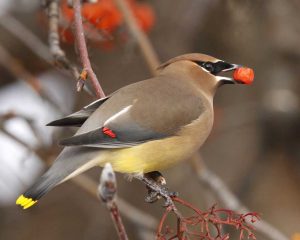Plant Berry Producers Now to Feed Birds in Fall
The first time I finally saw a cedar waxwing (my favorite bird) in person was moments after it banged into my coworker’s office window. We ran outside to see if it was alright, and found it sitting in the dirt looking a little stunned. Later that day it rejoined a crazed cloud of waxwings feasting on a nearby pyracantha bush chock full of brilliant red fall berries. It was a hilarious party to watch, with festive flitting from branch to branch and some waxwings picking, then passing a berry from one bird to another until someone finally gulped it down.
But did the waxwing that crashed into the window become “drunk” on the pyracantha berries? I’ve heard that common wisdom many times. Actually, pyracantha “berries” aren’t berries but pomes (like pears and stone fruit), and they don’t ferment to alcohol. They do contain hydrogen cyanide, a mild neurotoxin, which might make birds a little tipsy if eaten in large quantities.
Whether or not birds get loopy on certain berries, one thing is certain: in fall and winter when insects are not as plentiful, many bird species rely on berry-producing trees, bushes, vines and groundcovers, to either fatten up for migration or simply to sustain themselves on their home turf. An added bonus is that many of these plants also serve as a protective cover and as nesting sites; and in spring, their flowers draw pollinators, as well as insects that once again become the staple of birds’ diets. By finding and planting California-native berry producers now, gardeners can come even closer to syncing the seasonal food supply to what local wildlife (including migratory birds) has evolved with.
The Habitat Network, a citizen science project in partnership with the Cornell Lab of Ornithology and The Nature Conservancy, is a good resource for planning home landscapes in general, and in particular, for selecting berry-producing plants native to various environments. For example, their “Top Five Great Berries for Great Birds in Your Region” page suggests these plants native to California foothills chaparral: big saltbush, blue elderberry, California coffeeberry, red-osier dogwood and toyon. Their top-five picks for Pacific mixed forest (higher elevations) are osoberry, red elderberry, red-osier dogwood, salal, and Western serviceberry. The webpage tells you when each plant flowers and produces berries, which birds in your region are likely to consume the fruit, and which pollinators might frequent the flowers.
A longer list of berry-producing plants—some native, some not—to consider for foothill gardens include crabapples, mulberries, white oak, junipers, winterberry (holly), currants, viburnum—and of course, manzanita.
To keep birds in berries through fall and winter, choose a variety of plants that come into fruit at different times during these seasons. Some trees, like red-osier dogwood, are adorned with berries only in autumn, while crabapples, Virginia creeper and holly produce “winter-persistent berries,” which can decorate the plant until early spring.
Ironically, California native plants are often hard to find in the chain nurseries, so contact the Sierra Foothills chapter of the California Native Plant Society for advice about where to find your berry-producing plant of choice. Just don’t plant a pyracantha near a window.
Rachel Oppedahl is a University of California Cooperative Extension Master Gardener of Tuolumne County.
UCCE Master Gardeners of Tuolumne and Calaveras Counties can answer home gardening questions. Call 209-533-5912 in Tuolumne County, 209-754-2880 in Calaveras County or fill out our easy-to-use problem questionnaire here. Check out our website here. You can also find us on Facebook.

